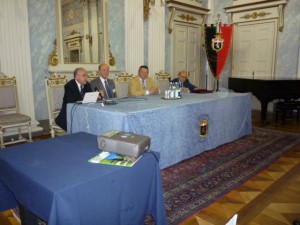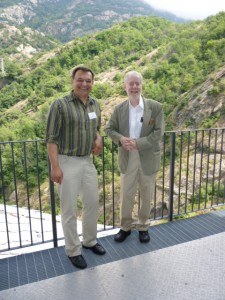Today we get into the heart of this interstellar conference, with multiple sessions on propulsion via solar and electric sail, as well as looks at specific mission concepts and robotic applications in deep space. I spent a good part of our bus ride back from Bard castle yesterday talking to Pekka Janhunen, creator of the electric sail concept, about its possible interstellar applications. Pekka does not believe this system, based on electric tethers riding the solar wind, could muster the velocity to go interstellar, but he does see it as a viable candidate for braking into a destination system, and just as important, exploring it. I’m anxious to get the latest on his work and also to look at fusion alternatives, which Claudio Maccone will present now that we’ve learned that Claudio Bruno can’t make it here.

As I get ready for the day to start, I’ll drop in here some notes from the first day. These are no more than a skeletal outline — I’ll use the conference proceedings when I get back to take a close look at some of these presentations, but I don’t want to rush through any complex arguments out of a need to get a post up.
Image: The opening session. That’s conference organizer Giancarlo Genta at the left, then (left to right) J.-M. Content, Guido Cossard (assessore of cultural affairs in Aosta) and Giovanni Vulpetti at far right.
Our opening session of the Aosta conference — technically, the Sixth IAA Symposium on Realistic Near-term Advanced Scientific Space Missions — got off to a late start, as so many meetings do, at the Aosta town hall on Monday. The keynote was a genial overview of the International Academy of Astronautics by its secretary general, J.-M. Content, who walked us through the major events that had shaped the organization. My session on ‘Interstellar Flight and the Public Imagination’ followed after a coffee break and we were off. Marco Bernasconi (MCB Consultants) followed me, which was fortuitous because we discussed many themes in common. Dr. Bernasconi has been working on human motivations for deep space travel for some time now and has developed an interesting libertarian perspective on the issue.
A short lunch at the hotel allowed us to get back on schedule in the conference rooms on the lower level, where Les Johnson (NASA MSFC) discussed NanoSail-D. Interesting to learn that there is no NanoSail-A, B or C — the ‘D’ stands for drag, and refers to the fact that in order to get the attempted launch funded, the Marshall Space Flight Center team had to sell the sail on the basis of its drag properties, useful in deorbiting satellites. That launch, of course, failed, another sail attempt wrecked not by the sail technology itself but by booster problems. Remember, a second NanoSail-D is still on the shelf in Huntsville. When will it fly?

Roman Kezerashvili (New York City College of Technology) talked about solar sails in the context of non-Keplerian orbits, but what I remember most about the afternoon was Kezerashvili’s impassioned defense of nuclear technology as the propulsion choice for the next step in space exploration. Giancarlo Genta, the organizer of the Aosta conference, spoke in his talk about the ‘nuclear renaissance’ in terms not only of the space program but also of the power industry. I want to get back to both the Genta and Kezerashvili talks later when I can go through their papers in detail. A second part of Kezerashvili’s argument will be presented on Thursday.
Image: Giancarlo Genta (Politecnico di Torino) answers a question during the afternoon session.

My erstwhile opponent in the interstellar bet, Tibor Pacher, made a pitch for unconventional thinking in presenting interstellar issues — these included a discussion not only of how we are using the Long Bets site to provoke discussion and commentary, but also of his own ‘Crazy Ideas’ section on the peregrinus-interstellar site and broader uses of social networking to get the public involved. Tibor made a huge and telling point when he looked around the room and asked: “Where are the young people?” Indeed, he himself was one of the youngest in the room and, as he told the crowd, he was almost 50. Here we were in Aosta discussing some of the cutting-edge technologies that might one day get us to the stars, and where were the students you would expect to find, the young intellects anxious to push that agenda? Tibor hopes his methods will help to remedy the lack, and so do I.
Image: Tibor Pacher (on the left) and I had paused to take in the view from Bard Castle when Claudio Maccone took this picture.
We also had an interesting talk on the psychological aspects of long-term flight from Nick Kanas (University of California at San Francisco), who brought his psychiatric credentials to bear in discussing how crews on long missions aboard Mir and the ISS have fared. All in all, a fine first day, capped by a banquet in the hotel dining room which was, as all our meals here have been, excellent. Giancarlo Genta turns out to be one of the great dinner companions in addition to being a crack symposium organizer. I’ll long remember our conversation about the history of the Aosta region. And Tuesday’s travels — we had a sightseeing day rather than any scientific sessions — were capped with a stop by his just completed summer home high above the valley, a glorious view of snow capped peaks dominating the sky, followed by a traditional Aosta dinner at a nearby restaurant. I’ll post some pictures of this in a day or two.


‘Where are all the young people?’
Reading that I thought, ‘Well, there’s Paul…’
I figured you to be in your thirties… Then I saw your picture.
It’s almost as though space lost its’ sexiness sometime in the ’60s.
paul thank you very much for that interesting update! hope to see many more and have a long and fruitful talk with our group here when you get back!!! by the way my friend,do you speak italian? lol my name may be scaglione,but i do not! enjoy your trip sounds great. your friend george
The solar wind travels about 300km/sec. This would put Alpha Centauri about 4,700 years away. That’s longer than what a scientific probe could justify but within the realm of consideration for an EGR mission. In e-mail conversations with Pekka he mentioned an expectation of only achieving about 30% of the speed of the solar wind. Did you guys get into why this might be?
Regarding a nuclear rennaisance, I wonder if Russian and Western space scientists could jointly advocate specific sxceptions to treaties to allow joint certain nuclear space ventures.
Incidentally, I believe that gusts of solar winds can get up to 800 km/sec putting Alpha Centauri less than 2,000 hrs away.
Hmmm… any women in the conference? The photos seem to say not. Don’t tell me the organizers “couldn’t find enough qualified” XXs.
“Pekka does not believe this system, based on electric tethers riding the solar wind, could muster the velocity to go interstellar, but he does see it as a viable candidate for braking into a destination system, and just as important, exploring it.”
I am curious about the asymmetry since acceleration and deceleration are the same thing: if you can brake from high velocity you should be able to do the reverse as well. Is there some other factor I’m missing?
George wrote:
George, I only wish I did! I do find myself picking up a few phrases because of prior study of Spanish and French, so it’s possible to generalize a bit into Italian. Wish I could do more.
John Hunt wrote:
2000 years maybe ;-) John, Pekka’s presentation was excellent, and he pointed out a lot of things about how he’s trying to get more performance out of the sail. Even so, there are various inefficiencies that are hard to remedy — I’d have to dig out the paper to tell you more, but riding the wind is not going to mean riding it at max speed. In any case, its variability is quite an issue, though Pekka thinks this can be managed in terms of navigation. Much depends, too, on the size of the tethers. He’s talking about a 20 kilometer baseline — if you go longer, you get higher speeds, etc. The prospect of nanotubes obviously got his attention when we had a presentation on them.
Athena wrote:
Well, we had a presentation yesterday on nanotubes from Rita Razzoli, who works on this stuff for a company whose names escapes me. But she’s been the only female.
Ron, Pekka talks about 150 kilometers per second as a hard to reach goal. He’s thinking that other propulsion systems would get us out of the Solar System much quicker, but that the sail could be used for long, slow deceleration on the other end. But this was just in a conversation on the bus, and he hasn’t really been thinking of this sail in interstellar terms. He might have more to say about this if I present him with your question, and I’ll try to if he hasn’t already left. People have started leaving already.
hello all,great to read all of the above comments! athena: i myself am sorry that tau zero seems to be mainly only a fraternity! on the rare occassion a woman or girl has said something here i have tried to answer her specifically right away so as to encourage her to join in more.alas it has never worked. as i have mentioned to paul i really hope we will all have a series of great discussions when he gets back. thank you one and all although under these unusual circumstances i wonder how many are reading here.still as always i hope for the best possible result and await the above mentioned discussions. your friend george
Paul, will they be producing a book on the subject, or making the presentations
available online? Thanks!
> but riding the wind is not going to mean riding it at max speed.
I would think that the electric sail would be turned on constantly until the craft reaches its maximum speed. Then it would be turned on only when gusts of the solar wind speed exceeded the speed of the craft. Does anyone know, if the electric sail can be turned on and off at will?
> In any case, its variability is quite an issue, though Pekka thinks this can be managed in terms of navigation.
Yes, I could imagine that it would be challenging but, I think, not insurmountable. One may need to turn on an off the electric charge strategically to follow an average desired course. And then turn it off completely after one is headed in the right direction.
> Much depends, too, on the size of the tethers.
Well, I would think that the max speed attainable would also depend upon the mass of the craft. The artistic rendering of the electric sail craft makes it look fairly massive. If minimally massive then it would be like a thin handkerchief wafting in the wind. It would accelerate to wind speed quickly.
ljk wrote:
Larry, I don’t know about what’s planned for online, but I believe the papers are to appear in Acta Astronautica. I’ll let you know more when I have confirmation.
Peter wrote:
Hey, wait a minute. I’m not that old! ;-)